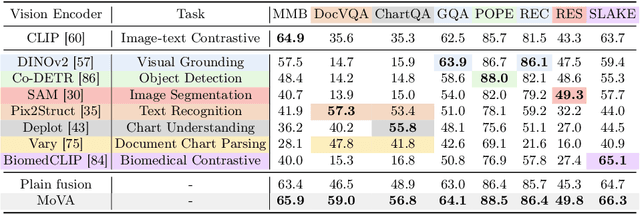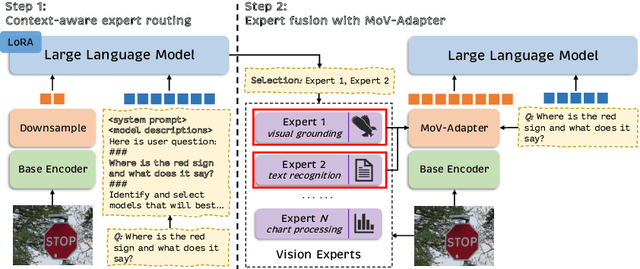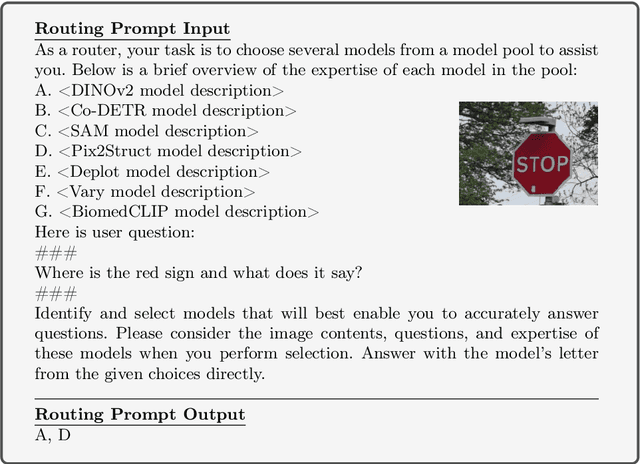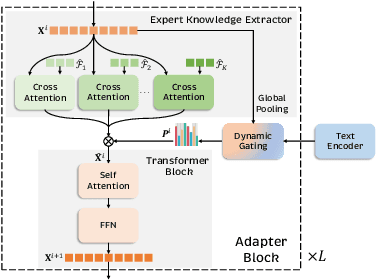Zhuofan Zong
WebGen-Agent: Enhancing Interactive Website Generation with Multi-Level Feedback and Step-Level Reinforcement Learning
Sep 26, 2025Abstract:Agent systems powered by large language models (LLMs) have demonstrated impressive performance on repository-level code-generation tasks. However, for tasks such as website codebase generation, which depend heavily on visual effects and user-interaction feedback, current code agents rely only on simple code execution for feedback and verification. This approach fails to capture the actual quality of the generated code. In this paper, we propose WebGen-Agent, a novel website-generation agent that leverages comprehensive and multi-level visual feedback to iteratively generate and refine the website codebase. Detailed and expressive text descriptions and suggestions regarding the screenshots and GUI-agent testing of the websites are generated by a visual language model (VLM), together with scores that quantify their quality. The screenshot and GUI-agent scores are further integrated with a backtracking and select-best mechanism, enhancing the performance of the agent. Utilizing the accurate visual scores inherent in the WebGen-Agent workflow, we further introduce \textit{Step-GRPO with Screenshot and GUI-agent Feedback} to improve the ability of LLMs to act as the reasoning engine of WebGen-Agent. By using the screenshot and GUI-agent scores at each step as the reward in Step-GRPO, we provide a dense and reliable process supervision signal, which effectively improves the model's website-generation ability. On the WebGen-Bench dataset, WebGen-Agent increases the accuracy of Claude-3.5-Sonnet from 26.4% to 51.9% and its appearance score from 3.0 to 3.9, outperforming the previous state-of-the-art agent system. Additionally, our Step-GRPO training approach increases the accuracy of Qwen2.5-Coder-7B-Instruct from 38.9% to 45.4% and raises the appearance score from 3.4 to 3.7.
T2I-R1: Reinforcing Image Generation with Collaborative Semantic-level and Token-level CoT
May 01, 2025Abstract:Recent advancements in large language models have demonstrated how chain-of-thought (CoT) and reinforcement learning (RL) can improve performance. However, applying such reasoning strategies to the visual generation domain remains largely unexplored. In this paper, we present T2I-R1, a novel reasoning-enhanced text-to-image generation model, powered by RL with a bi-level CoT reasoning process. Specifically, we identify two levels of CoT that can be utilized to enhance different stages of generation: (1) the semantic-level CoT for high-level planning of the prompt and (2) the token-level CoT for low-level pixel processing during patch-by-patch generation. To better coordinate these two levels of CoT, we introduce BiCoT-GRPO with an ensemble of generation rewards, which seamlessly optimizes both generation CoTs within the same training step. By applying our reasoning strategies to the baseline model, Janus-Pro, we achieve superior performance with 13% improvement on T2I-CompBench and 19% improvement on the WISE benchmark, even surpassing the state-of-the-art model FLUX.1. Code is available at: https://github.com/CaraJ7/T2I-R1
ADT: Tuning Diffusion Models with Adversarial Supervision
Apr 15, 2025Abstract:Diffusion models have achieved outstanding image generation by reversing a forward noising process to approximate true data distributions. During training, these models predict diffusion scores from noised versions of true samples in a single forward pass, while inference requires iterative denoising starting from white noise. This training-inference divergences hinder the alignment between inference and training data distributions, due to potential prediction biases and cumulative error accumulation. To address this problem, we propose an intuitive but effective fine-tuning framework, called Adversarial Diffusion Tuning (ADT), by stimulating the inference process during optimization and aligning the final outputs with training data by adversarial supervision. Specifically, to achieve robust adversarial training, ADT features a siamese-network discriminator with a fixed pre-trained backbone and lightweight trainable parameters, incorporates an image-to-image sampling strategy to smooth discriminative difficulties, and preserves the original diffusion loss to prevent discriminator hacking. In addition, we carefully constrain the backward-flowing path for back-propagating gradients along the inference path without incurring memory overload or gradient explosion. Finally, extensive experiments on Stable Diffusion models (v1.5, XL, and v3), demonstrate that ADT significantly improves both distribution alignment and image quality.
VividFace: A Diffusion-Based Hybrid Framework for High-Fidelity Video Face Swapping
Dec 15, 2024



Abstract:Video face swapping is becoming increasingly popular across various applications, yet existing methods primarily focus on static images and struggle with video face swapping because of temporal consistency and complex scenarios. In this paper, we present the first diffusion-based framework specifically designed for video face swapping. Our approach introduces a novel image-video hybrid training framework that leverages both abundant static image data and temporal video sequences, addressing the inherent limitations of video-only training. The framework incorporates a specially designed diffusion model coupled with a VidFaceVAE that effectively processes both types of data to better maintain temporal coherence of the generated videos. To further disentangle identity and pose features, we construct the Attribute-Identity Disentanglement Triplet (AIDT) Dataset, where each triplet has three face images, with two images sharing the same pose and two sharing the same identity. Enhanced with a comprehensive occlusion augmentation, this dataset also improves robustness against occlusions. Additionally, we integrate 3D reconstruction techniques as input conditioning to our network for handling large pose variations. Extensive experiments demonstrate that our framework achieves superior performance in identity preservation, temporal consistency, and visual quality compared to existing methods, while requiring fewer inference steps. Our approach effectively mitigates key challenges in video face swapping, including temporal flickering, identity preservation, and robustness to occlusions and pose variations.
EasyRef: Omni-Generalized Group Image Reference for Diffusion Models via Multimodal LLM
Dec 12, 2024



Abstract:Significant achievements in personalization of diffusion models have been witnessed. Conventional tuning-free methods mostly encode multiple reference images by averaging their image embeddings as the injection condition, but such an image-independent operation cannot perform interaction among images to capture consistent visual elements within multiple references. Although the tuning-based Low-Rank Adaptation (LoRA) can effectively extract consistent elements within multiple images through the training process, it necessitates specific finetuning for each distinct image group. This paper introduces EasyRef, a novel plug-and-play adaptation method that enables diffusion models to be conditioned on multiple reference images and the text prompt. To effectively exploit consistent visual elements within multiple images, we leverage the multi-image comprehension and instruction-following capabilities of the multimodal large language model (MLLM), prompting it to capture consistent visual elements based on the instruction. Besides, injecting the MLLM's representations into the diffusion process through adapters can easily generalize to unseen domains, mining the consistent visual elements within unseen data. To mitigate computational costs and enhance fine-grained detail preservation, we introduce an efficient reference aggregation strategy and a progressive training scheme. Finally, we introduce MRBench, a new multi-reference image generation benchmark. Experimental results demonstrate EasyRef surpasses both tuning-free methods like IP-Adapter and tuning-based methods like LoRA, achieving superior aesthetic quality and robust zero-shot generalization across diverse domains.
Exploring the Role of Large Language Models in Prompt Encoding for Diffusion Models
Jun 17, 2024Abstract:Large language models (LLMs) based on decoder-only transformers have demonstrated superior text understanding capabilities compared to CLIP and T5-series models. However, the paradigm for utilizing current advanced LLMs in text-to-image diffusion models remains to be explored. We observed an unusual phenomenon: directly using a large language model as the prompt encoder significantly degrades the prompt-following ability in image generation. We identified two main obstacles behind this issue. One is the misalignment between the next token prediction training in LLM and the requirement for discriminative prompt features in diffusion models. The other is the intrinsic positional bias introduced by the decoder-only architecture. To deal with this issue, we propose a novel framework to fully harness the capabilities of LLMs. Through the carefully designed usage guidance, we effectively enhance the text representation capability for prompt encoding and eliminate its inherent positional bias. This allows us to integrate state-of-the-art LLMs into the text-to-image generation model flexibly. Furthermore, we also provide an effective manner to fuse multiple LLMs into our framework. Considering the excellent performance and scaling capabilities demonstrated by the transformer architecture, we further design an LLM-Infused Diffusion Transformer (LI-DiT) based on the framework. We conduct extensive experiments to validate LI-DiT across model size and data size. Benefiting from the inherent ability of the LLMs and our innovative designs, the prompt understanding performance of LI-DiT easily surpasses state-of-the-art open-source models as well as mainstream closed-source commercial models including Stable Diffusion 3, DALL-E 3, and Midjourney V6. The powerful LI-DiT-10B will be available after further optimization and security checks.
MoVA: Adapting Mixture of Vision Experts to Multimodal Context
Apr 19, 2024



Abstract:As the key component in multimodal large language models (MLLMs), the ability of the visual encoder greatly affects MLLM's understanding on diverse image content. Although some large-scale pretrained vision encoders such as vision encoders in CLIP and DINOv2 have brought promising performance, we found that there is still no single vision encoder that can dominate various image content understanding, e.g., the CLIP vision encoder leads to outstanding results on general image understanding but poor performance on document or chart content. To alleviate the bias of CLIP vision encoder, we first delve into the inherent behavior of different pre-trained vision encoders and then propose the MoVA, a powerful and novel MLLM, adaptively routing and fusing task-specific vision experts with a coarse-to-fine mechanism. In the coarse-grained stage, we design a context-aware expert routing strategy to dynamically select the most suitable vision experts according to the user instruction, input image, and expertise of vision experts. This benefits from the powerful model function understanding ability of the large language model (LLM) equipped with expert-routing low-rank adaptation (LoRA). In the fine-grained stage, we elaborately conduct the mixture-of-vision-expert adapter (MoV-Adapter) to extract and fuse task-specific knowledge from various experts. This coarse-to-fine paradigm effectively leverages representations from experts based on multimodal context and model expertise, further enhancing the generalization ability. We conduct extensive experiments to evaluate the effectiveness of the proposed approach. Without any bells and whistles, MoVA can achieve significant performance gains over current state-of-the-art methods in a wide range of challenging multimodal benchmarks. Codes and models will be available at https://github.com/TempleX98/MoVA.
CoMat: Aligning Text-to-Image Diffusion Model with Image-to-Text Concept Matching
Apr 04, 2024



Abstract:Diffusion models have demonstrated great success in the field of text-to-image generation. However, alleviating the misalignment between the text prompts and images is still challenging. The root reason behind the misalignment has not been extensively investigated. We observe that the misalignment is caused by inadequate token attention activation. We further attribute this phenomenon to the diffusion model's insufficient condition utilization, which is caused by its training paradigm. To address the issue, we propose CoMat, an end-to-end diffusion model fine-tuning strategy with an image-to-text concept matching mechanism. We leverage an image captioning model to measure image-to-text alignment and guide the diffusion model to revisit ignored tokens. A novel attribute concentration module is also proposed to address the attribute binding problem. Without any image or human preference data, we use only 20K text prompts to fine-tune SDXL to obtain CoMat-SDXL. Extensive experiments show that CoMat-SDXL significantly outperforms the baseline model SDXL in two text-to-image alignment benchmarks and achieves start-of-the-art performance.
Visual CoT: Unleashing Chain-of-Thought Reasoning in Multi-Modal Language Models
Mar 25, 2024



Abstract:This paper presents Visual CoT, a novel pipeline that leverages the reasoning capabilities of multi-modal large language models (MLLMs) by incorporating visual Chain-of-Thought (CoT) reasoning. While MLLMs have shown promise in various visual tasks, they often lack interpretability and struggle with complex visual inputs. To address these challenges, we propose a multi-turn processing pipeline that dynamically focuses on visual inputs and provides interpretable thoughts. We collect and introduce the Visual CoT dataset comprising 373k question-answer pairs, annotated with intermediate bounding boxes highlighting key regions essential for answering the questions. Importantly, the introduced benchmark is capable of evaluating MLLMs in scenarios requiring specific local region identification. Extensive experiments demonstrate the effectiveness of our framework and shed light on better inference strategies. The Visual CoT dataset, benchmark, and pre-trained models are available to foster further research in this direction.
RAPHAEL: Text-to-Image Generation via Large Mixture of Diffusion Paths
May 29, 2023



Abstract:Text-to-image generation has recently witnessed remarkable achievements. We introduce a text-conditional image diffusion model, termed RAPHAEL, to generate highly artistic images, which accurately portray the text prompts, encompassing multiple nouns, adjectives, and verbs. This is achieved by stacking tens of mixture-of-experts (MoEs) layers, i.e., space-MoE and time-MoE layers, enabling billions of diffusion paths (routes) from the network input to the output. Each path intuitively functions as a "painter" for depicting a particular textual concept onto a specified image region at a diffusion timestep. Comprehensive experiments reveal that RAPHAEL outperforms recent cutting-edge models, such as Stable Diffusion, ERNIE-ViLG 2.0, DeepFloyd, and DALL-E 2, in terms of both image quality and aesthetic appeal. Firstly, RAPHAEL exhibits superior performance in switching images across diverse styles, such as Japanese comics, realism, cyberpunk, and ink illustration. Secondly, a single model with three billion parameters, trained on 1,000 A100 GPUs for two months, achieves a state-of-the-art zero-shot FID score of 6.61 on the COCO dataset. Furthermore, RAPHAEL significantly surpasses its counterparts in human evaluation on the ViLG-300 benchmark. We believe that RAPHAEL holds the potential to propel the frontiers of image generation research in both academia and industry, paving the way for future breakthroughs in this rapidly evolving field. More details can be found on a project webpage: https://raphael-painter.github.io/.
 Add to Chrome
Add to Chrome Add to Firefox
Add to Firefox Add to Edge
Add to Edge